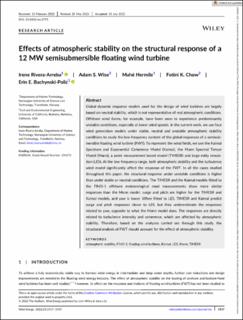| dc.description.abstract | Global dynamic response models used for the design of wind turbines are largely based on neutral stability, which is not representative of real atmospheric conditions. Offshore wind farms, for example, have been seen to experience predominantly unstable conditions, especially at lower wind speeds. In the current work, we use four wind generation models under stable, neutral and unstable atmospheric stability conditions to study the low-frequency content of the global responses of a semisubmersible floating wind turbine (FWT). To represent the wind fields, we use the Kaimal Spectrum and Exponential Coherence Model (Kaimal), the Mann Spectral Tensor Model (Mann), a point measurement based model (TIMESR) and large-eddy simulation (LES). At the low-frequency range, both atmospheric stability and the turbulence wind model significantly affect the response of the FWT. In all the cases studied throughout this paper, the structural response under unstable conditions is higher than under stable or neutral conditions. The TIMESR and the Kaimal models fitted to the FINO-1 offshore meteorological mast measurements show more similar responses than the Mann model; surge and pitch are higher for the TIMESR and Kaimal models, and yaw is lower. When fitted to LES, TIMESR and Kaimal predict surge and pitch responses closer to LES, but they underestimate the responses related to yaw, opposite to what the Mann model does. The responses are directly related to turbulence intensity and coherence, which are affected by atmospheric stability. Therefore, based on the analyses carried out through this study, the structural analysis of FWT should account for the effect of atmospheric stability. | en_US |

